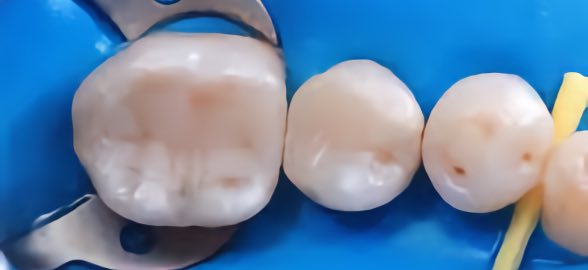Have you ever wondered why there is such a big price difference between one polymerization lamp and another? The price is not only associated with the design and fittings of the polymerisation lamp, but also with its functions and technical characteristics such as weight, wavelength or output power.
In today’s article we will tell you everything you need to know about polymerization lamps:
- What to consider when choosing one.
- The different types of light curing lamps that exist.
- What makes them different.
- Models of light curing lamps according to their price range.
- How to prevent and troubleshoot polymerization lamps.
Are you ready? Let’s start!

Image source: Ultradent
The function of polymerization lamps is to polymerize light-sensitive resins in restoration processes and to accelerate some bleaching treatments. For lasting dental restorations a proper polymerization is essential, which will depend on:
- A light source with a certain power: At least 1,000 mW/cm2 is needed to polymerize in 10 seconds through a dental structure in indirect restorations. However, for direct restorations at least 400 mW/cm2 output power is required
- Exposure time.
- The quality of light.
- Suitable wavelength: the larger the wavelength range, the better it will adapt to the wavelengths of each type of composite.
- The energy and heat released.
Also, depending on what we are going to use the light curing lamp in our dental clinic, We must take into account some technical and functional aspects to be taken into account when choosing a light curing lamp.
What should be considered when choosing a light curing lamp?
Before you can choose the ideal polymerization lamp for your dental clinic, it is essential that you know what use it will be. You should be very clear about the type of composites you will work with to know the technical requirements to consider during the election.
1. Intensity:
The more intensity the lamp can give you, the better, because it will give you more chances to polymerize the composites at greater depth. In high-end lamps, it is also interesting that low intensities can be achieved because it will allow you to adapt it to the needs of each clinical case or treatment.
2. Wavelength amplitude:
It is important that the lamp can offer you the widest possible range of wavelengths to adapt to the optimal wavelengths of each type of composite and be able to use with the maximum number of resins possible.
If you know that you are always working with the same types of composite, you can buy a lamp that reaches the required wavelength well and you do not need it to have a very wide range of wavelengths.
3. Polymerization programs
Today, all lamps are normally equipped with at least 3 different programs for polymerization in different ways according to the treatment needs:
- Ramp Up: Progressive increase in intensity.
- Step: Switch between intensity 0 and maximum.
- Maximum power level consistently.
High-end lamps can incorporate more types of programs and functions, such as blue light caries detection.
4. Lamp design
Although this aspect can be very subjective, it is important that the lamp has good design to convey a sense of modernity, cleanliness and technology to your patients. It is also very important to take into account the weight and ergonomics of the light curing lamp.
5. Wireless or wired lamps
Today almost all lamps are wireless, which offers great working comfort. However, when choosing a lamp, one must take into account the durability of the battery and the duration of the charge.
In addition to all these aspects, it is very important to buy a light curing lamp that has a guarantee and good after-sales service to be able to give adequate maintenance and can easily purchase spare parts.
What are the different types of polymerization lamps?
From Dentaltix we offer some tips to help you choose the best light curing lamp that suits your needs and we will recommend some of the best proposals currently available on the market.
Halogen Dental Polymerization Lamps
They were invented more than 20 years ago and are incandescent lamps that produce infrared and consequently heat. They are equipped with an optical filter so that the temperature does not rise excessively. Its drawback is that much of the energy produced is wasted and generates a lot of heat.
Plasma Arc Dental Polymerization Lamps
These lamps produce light through an electric arc discharge between 2 tungsten electrodes. They have the advantage over halogens of achieving a higher light intensity, generating a faster and deeper photocuring. What is their disadvantage? Its price is high and its wavelength is reduced, so sometimes with some resins it is not effective and does not work.
Laser dental polymerization lamps
These lamps produce a wavelength that allows polymerization of composites but with a very high shrinkage, so this is a major disadvantage. It is also very expensive.
The plasma and laser arc curing lamps, despite their high light output of between 1400 and 2700 mW/cm2, did not succeed in the market because they generated too much heat and were expensive. The same is happening with halogen light bulbs, which are gradually being replaced by LED light curing lamps (Light Emitting Diode) as they have some advantages over halogen: they consume little energy, generate less heat and have a much longer service life.
LED Dental Polymerization Lamps
These lamps are currently the most efficient: they convert electrical energy into light. You will be able to reduce the exposure time and heat produced by 50%, ensuring a longer service life. They are also quiet, do not require ventilation and have low power consumption.
Indeed, the latest generation of LED curing lights are both cheaper and more expensive, characterized by ergonomics that benefit the user comfort and by being smaller, lighter and easier to clean.
Take a look at the most common light-curing lamps used in dental clinics:
How to fix malfunctions in dental polymerization lamps?
It is very important to keep our polymerization lamps in good condition so that they can be used for longer periods of time. Here are some recommendations that will help you to maintain good care and use of the same and thus avoid many failures:
- Do not overload the battery.
- Place the dental polymerization lamp correctly inside the base
- One of the most common failures is for the optical fiber for light curing lamp: prevent falls from it to avoid breakage. You must be very careful with this delicate part of the lamp.
Another important element is the radiometer; a device that measures the energy emitted by the photocuring units. The use of this device in your clinic is necessary to monitor and ensure a complete and safe polymerization. The radiometer also warns of the need to change or repair the lamp. So it is important that the lamp has the radiometer to measure output power.
We hope this article will help you choose curing lamps for your dental practice more easily. Do not hesitate to contact us if you have any questions regarding the lamps, we will be happy to support you.


